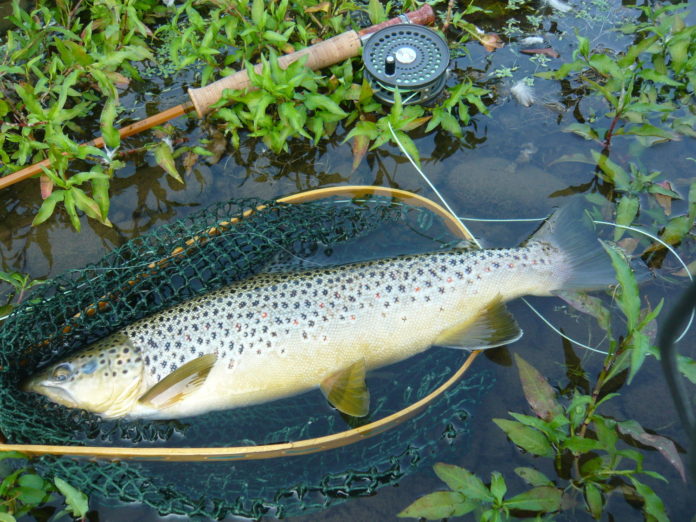By TONY BONAVIST
About a week ago, I sent an email to friends I fish with, inviting them to our camp for the annual spring gettogether. This is what I wrote in the subject line: “Pick Up Sticks.” Each year after a long and, in this case, windy, Catskill winter, a lot of small branches from the large poplar tree close to our RV were down. So each spring, we meet to clean up before the mowing begins. I told everyone to bring their rods, just in case.
After the branches were gathered and piled neatly off to the side, we had a bit of lunch and contemplated the afternoons’ fishing. Around 3 o’clock, we all headed to different parts of the river to see if there were flies hatching.
I chose to fish the “Home Pool” that flows through the meadow just behind our RV. It’s a side channel, separate from the main river and, in previous years, holds a decent population of large trout. When I arrived, there were a few very small, tan caddis in the air and no other insect activity. This reach of the river is a very long glide that meanders for at least 200 yards before joining the main stem. The current is imperceptible here, especially this year with very low stream flow. There is a little point that juts into the river where I stopped to tie on a fly and check the water for flies. My next task was to wade in to see if the very old Simms waders I sealed a few weeks ago leak.
At the same time, I wondered whether, as age creeps up, these old legs will be up to the rigors of wading one more season. I’m about to find out. There was a time when I walked into a river with great confidence. Not anymore. Now, I carefully slide into the water, making sure not to slip on the muddy bank. Once in, I wade out deep enough to see if my waders are leaking. This time, I was up to my knees—so far, so good.
As fly fishers, we are always searching the water for flies and rising trout. There were only a few small blue quills on the water, but no trout rising. So I looked upstream where I saw two rises near the head of the pool. I had two options: either re-trace my steps, climb out and walk back, or wade to where the trout are rising. I chose the latter and slowly begin to move upriver. Frankly, I wanted to see if my legs were up for the task. As I moved forward, I found the river bottom was covered with about 12 inches of muck. It doesn’t make for easy wading; I had to pull my foot out the muck with each step, and it took considerable effort to move along. It was slow going, but I finally reached the head of the pool to find Hendricksons on the water and those two trout, sporadically rising. More importantly, I was very pleased that I was able to wade this difficult stretch of river bottom without incident.
The two rises were trout feeding across and down from where I was standing. They’re about 30 feet away on the other side of the main current, which would make a drag free float difficult.
With Hendricksons on the water, I selected a classic Catskill-style fly and knotted it to my 5X tippet. It was a bright sunny afternoon with low streamflow, so I was concerned about spooking the trout. I tried about a dozen casts, with no results, and look at my leader as it floats along. In the bright sun, it looked like a cable on the water’s surface. I retrieved the leader and looked at my fly resting on the water’s surface. It looked nothing at all like the natural insects. While classic, Catskill-tied dry flies usually work very well, particularly early in the season—not today. I considered what to try next—a small rusty spinner? I’ve used this fly hundreds of times, but mostly in the evening. So, I replaced the 5X tippet with 6X and tied on a #16 rusty spinner. The closest fish took the rusty spinner on the second drift. At first, this trout didn’t feel very large and just held with the current. Suddenly, it took off on a very long run, taking most of my fly line. Then it jumped, and I saw that this fish was a sizable brown trout. With very cold water temperatures at this time of year and associated high oxygen concentrations, it took almost 15 minutes to bring this feisty trout to the net. When I measured, she was a solid 20 inches. Not bad for the first trout of the season!
So, why did this trout take a rusty spinner and not a classically tied, Catskill-style dry fly? While I cannot be 100 percent certain, I firmly believe that spinner-type dry flies, which float in the surface film, look more realistic and are easier to see by trout. So, in the future, I’m going to try spinner-type flies during mayfly hatches. I’ll know soon enough whether that day’s result with a rusty spinner was a fluke or, perhaps, a more productive way to fish.
Credit: Source link






























